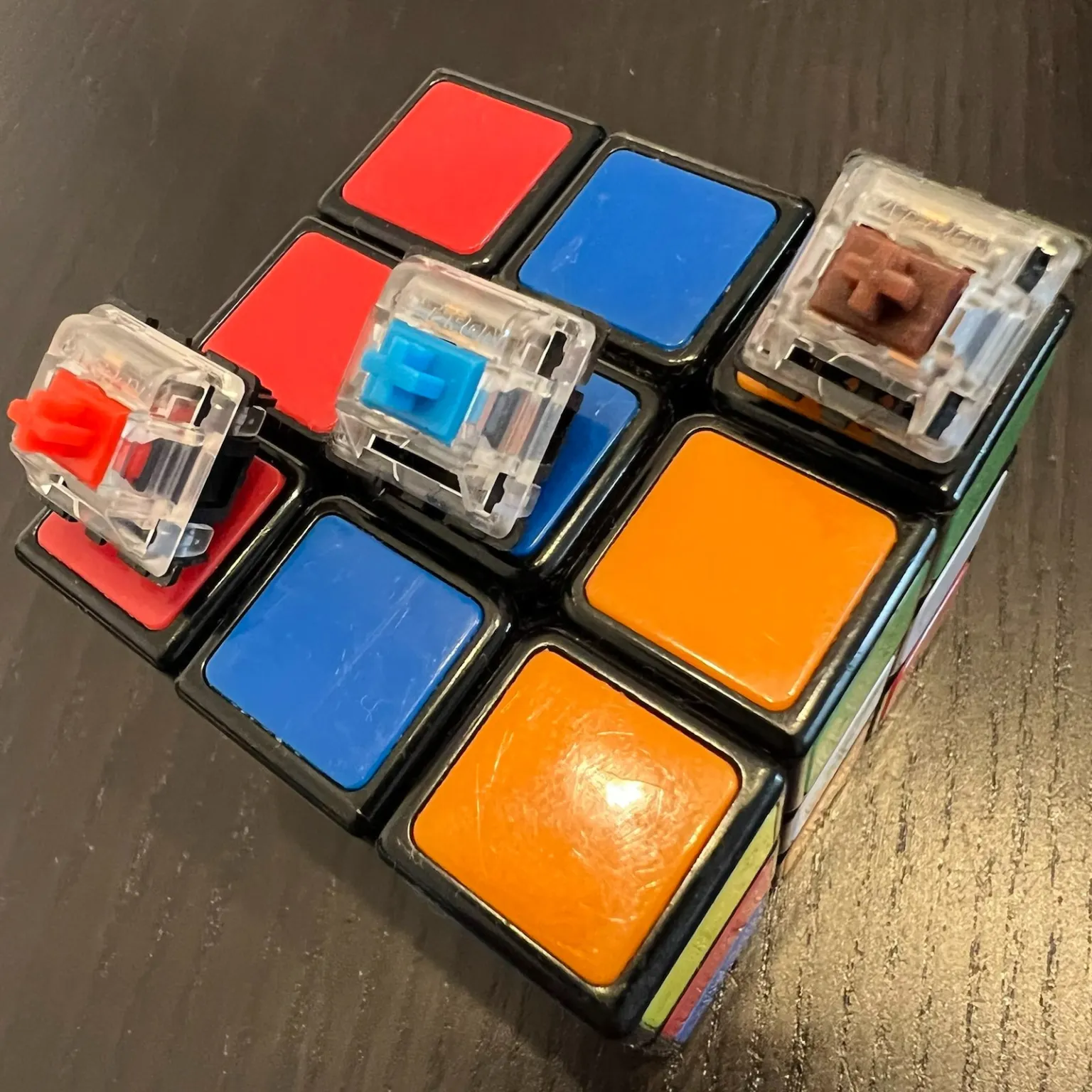In today’s post, I want to talk about the most important component of any mechanical keyboard – the switches. I’ll cover the three basic types: Cherry MX Red, Brown, and Blue. I’ll explain how they work, list their parameters, outline their key features, and describe the differences between them.
Why only three switches? Because if you’re just starting your adventure with mechanical keyboards, these are the best place to begin. Although the market offers dozens (if not hundreds) of different switches, many of them differ only in small nuances that are hard to notice at the start. Some are clones of others, and some are just minor variations—such as being slightly quieter or requiring slightly more force to press.
What Are Cherry MX Red, Brown, and Blue Switches?
These three switches represent the three core types of switches made by Cherry MX:
Red – linear
Brown – tactile
Blue – clicky
When we talk about switches, we usually mention the manufacturer and then the color—because the stem color determines how the switch behaves. That’s why you’ll often hear terms like “Brown switches,” “Red switches,” or “Blue switches.”
Below I’ll briefly describe each type, provide a short summary, and share my personal opinion and ranking of these switches.
Cherry MX Red – Linear
Actuation force: ~45 cN
Actuation point: 2.0 mm
Total travel distance: 4.0 mm
Sound: silent
Feel: completely smooth—there’s no noticeable point where the key activates.
 https://www.cherrymx.de/en/cherry-mx/mx-original/mx-red.html#techSpecs
https://www.cherrymx.de/en/cherry-mx/mx-original/mx-red.html#techSpecs
Cherry MX Red switches are perfect for gaming, where fast and effortless key presses matter most. Since there’s no tactile bump or click, you can press them quickly and repeatedly with minimal effort.
Cherry MX Brown – Tactile
Actuation force: ~55 cN
Actuation point: 2.0 mm
Total travel distance: 4.0 mm
Sound: quiet, soft “thock”
Feel: there’s a noticeable bump when the key activates, but no loud click.
 https://www.cherrymx.de/en/cherry-mx/mx-original/mx-brown.html#techSpecs
https://www.cherrymx.de/en/cherry-mx/mx-original/mx-brown.html#techSpecs
These switches are extremely versatile—ideal for both typing and gaming. The tactile bump gives you subtle feedback, letting you feel exactly when the key activates. This makes Cherry MX Browns a great all-around switch.
Cherry MX Blue – Clicky
Actuation force: ~60 cN
Actuation point: 2.2 mm
Total travel distance: 4.0 mm
Sound: loud and clicky
Feel: clear tactile bump combined with a distinct click sound.
 https://www.cherrymx.de/en/cherry-mx/mx-original/mx-blue.html#techSpecs
https://www.cherrymx.de/en/cherry-mx/mx-original/mx-blue.html#techSpecs
Cherry MX Blue switches are ideal for those who love the feel of old-school typewriters. They give strong tactile feedback and a satisfying click. Many writers and programmers enjoy using them. However, their sound can be bothersome to others—especially in a shared space or at home.
Summary Table
| Switch Type | Feel | Actuation Force | Actuation Point | Sound |
|---|---|---|---|---|
| Red | Linear | 45 cN | 2.0 mm | Silent |
| Brown | Tactile | 55 cN | 2.0 mm | Quiet “thock” |
| Blue | Clicky | 60 cN | 2.2 mm | Loud click |
Which Switch Should You Choose?
Red switches – ideal for gaming where fast response is key.
Blue switches – perfect for typing and writing if you enjoy audible feedback.
Brown switches – a great middle ground: tactile, responsive, and quiet enough for most environments.
My Personal Ranking
🥉 Bronze – Cherry MX Red
Personally, I didn’t enjoy this switch much. I type a lot, and I missed both the tactile feel and the sound. These switches felt a bit too soft and “empty” to me.🥈 Silver – Cherry MX Blue
A great, expressive switch. It reminded me of old typewriters, which I found enjoyable. But after a full day of use, the loud click began to bother not just me, but also my family. So eventually, I had to let it go.🥇 Gold – Cherry MX Brown
My absolute favorite. I now build all my keyboards using Brown switches. They offer the perfect balance between tactile feel and sound. You can feel exactly when the key registers, and the subtle “thock” is very pleasant without being annoying. I highly recommend them for typing, coding, and gaming. They work great in ergonomic keyboards, too.
Let me know which switches you use and why! And if you’re new to the world of mechanical keyboards, start with these three. They’re a solid base—and from there, you can dive deeper into other types later.
Thanks for reading!
Bartosz
